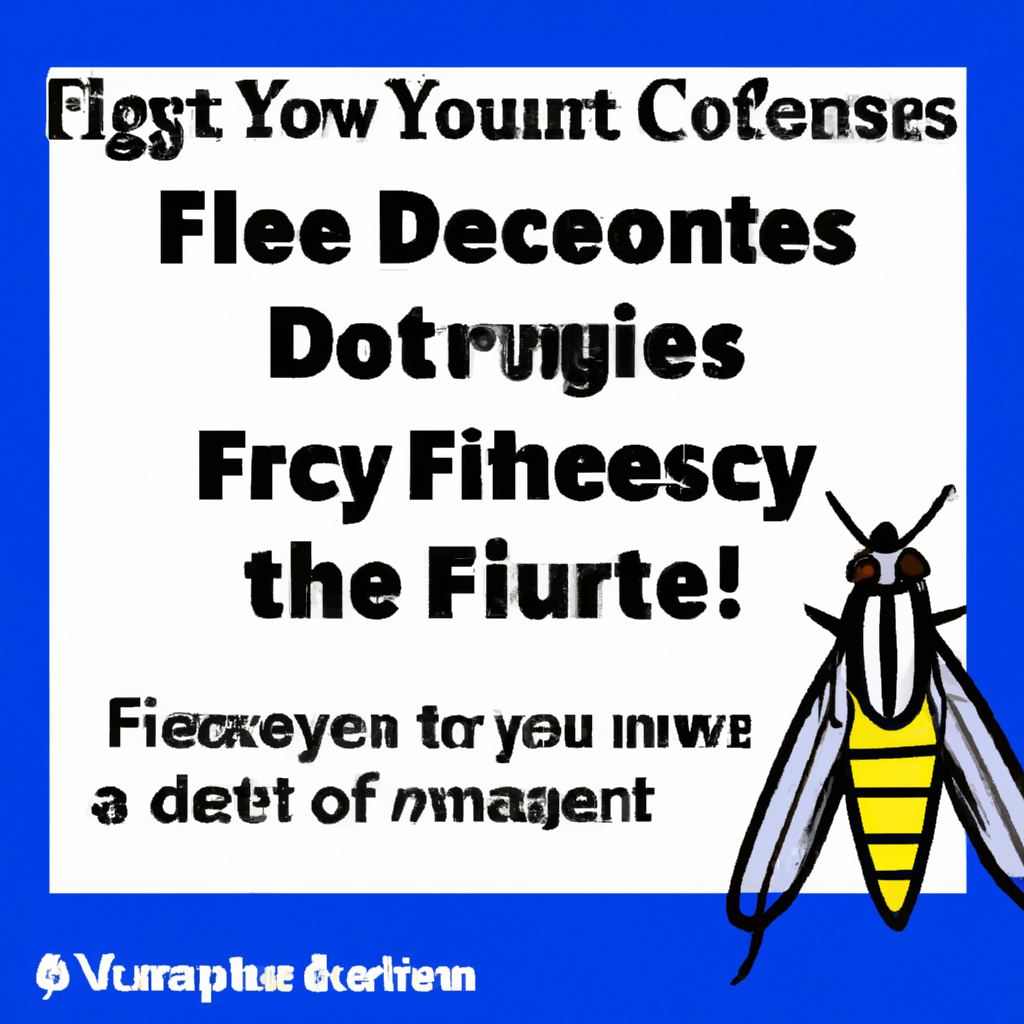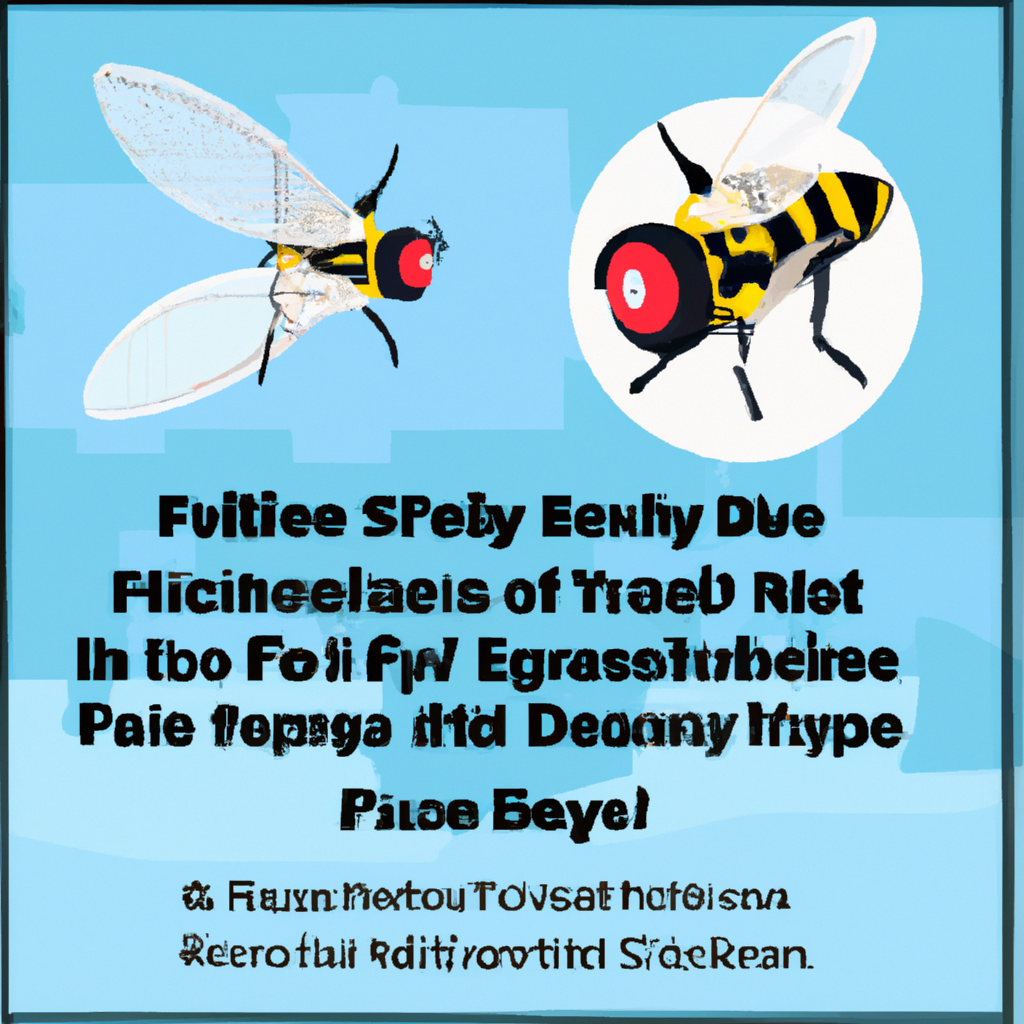Are flies buzzing around your house, disrupting your peace and spreading germs? Say goodbye to these pesky insects with these effective methods to eliminate flies in your house. From simple DIY traps to natural repellents, we will show you how to get rid of flies in your house and regain a fly-free environment. With these easy tips and tricks, you’ll have a clean and fly-free home in no time.
Preventing Entry of Flies
Seal Cracks and Gaps
To prevent flies from entering your house, it is essential to seal any cracks or gaps in doors, windows, walls, and other entry points. Flies can easily squeeze through even the tiniest openings, so it’s important to inspect your home for any potential entry points and seal them using caulk, weatherstripping, or other suitable materials. By eliminating these entry points, you can significantly reduce the chances of flies finding their way into your house.
Install Fly Screens
Another effective way to prevent flies from entering your house is by installing fly screens on your doors and windows. Fly screens are mesh screens that allow fresh air to circulate while preventing flies and other insects from entering. These screens are easy to install and can be found in various sizes to fit different types of doors and windows. By using fly screens, you can keep your home well-ventilated without worrying about flies invading your living spaces.
Keep Doors and Windows Closed
A simple yet crucial step in preventing flies from entering your house is to keep doors and windows closed as much as possible. Flies are opportunistic insects, and an open door or window can be an invitation for them to enter. Make it a habit to close doors and windows promptly after use, especially during seasons when flies are most active. By maintaining a barrier between the outside and inside of your home, you significantly reduce the risk of flies making their way in.
Use Door Sweepers
Door sweepers are a nifty device that you can install at the bottom of your doors. These sweepers create a seal when the door is closed, preventing flies and other insects from getting through the gap at the bottom. Door sweepers are easy to install and come in different types, such as adhesive sweepers or ones with adjustable height. By using door sweepers, you can further fortify your defense against flies and keep them out of your living spaces.
Eliminate Attractive Environments
Flies are often attracted to environments that offer them easy access to food, water, and breeding grounds. To prevent flies from infesting your house, it is essential to eliminate these attractive environments. Keep your kitchen clean and free from food crumbs, store food in tightly sealed containers, and promptly clean up any spills. Additionally, make sure there are no standing water sources inside or near your house, as flies are drawn to damp areas for breeding. By removing these attractive environments, you make your home less appealing to flies and discourage their presence.
Using Natural Repellents
Essential Oils
Using essential oils is a natural and effective way to repel flies from your house. Flies dislike the strong scents of certain essential oils, making them an excellent deterrent. Peppermint, eucalyptus, lavender, and lemongrass essential oils are known to repel flies. Create a homemade fly repellent by mixing a few drops of these essential oils with water in a spray bottle, and mist it around areas where flies commonly gather. Using essential oils not only helps keep flies away but also adds a pleasant fragrance to your living spaces.
Vinegar
Vinegar is a versatile household ingredient that can also be used as a natural fly repellent. Fill a bowl or a small container with vinegar and place it in areas where flies are most active, such as near windows, doors, or trash bins. Flies find the scent of vinegar unpleasant and will be deterred from coming near. Additionally, you can create a vinegar fly trap by covering a glass or jar with plastic wrap, poking a few small holes in it, and placing some vinegar inside. Flies will be attracted to the scent, enter through the holes, and get trapped inside the container.
Cinnamon Sticks
The strong scent of cinnamon is highly effective in repelling flies. Place cinnamon sticks in areas where flies are likely to frequent, such as near windows, doors, or kitchen countertops. You can also create a homemade fly repellent spray by boiling cinnamon sticks in water, allowing it to cool, and transferring it to a spray bottle. Spraying this mixture around your house will not only repel flies but also leave a pleasant aroma.
Citrus Peels
Flies have a strong aversion to the scent of citrus fruits. Collect citrus peels from fruits like lemons, oranges, or grapefruits and place them in areas where flies are a nuisance. You can place the peels directly on windowsills or attach them to string and hang them near door entrances. The natural oils released from the citrus peels act as a fly repellent, keeping these pesky insects at bay.
Herbs and Plants
Certain herbs and plants possess natural fly-repellent properties. Planting these around your house can help deter flies from coming too close. Some examples of these plants include basil, mint, lavender, and marigold. You can either grow these herbs and plants in pots and place them near entrances or windows or create small bouquets of fresh herbs to place in different areas of your house. Not only will these plants act as natural fly repellents, but they will also add a touch of greenery and freshness to your living spaces.
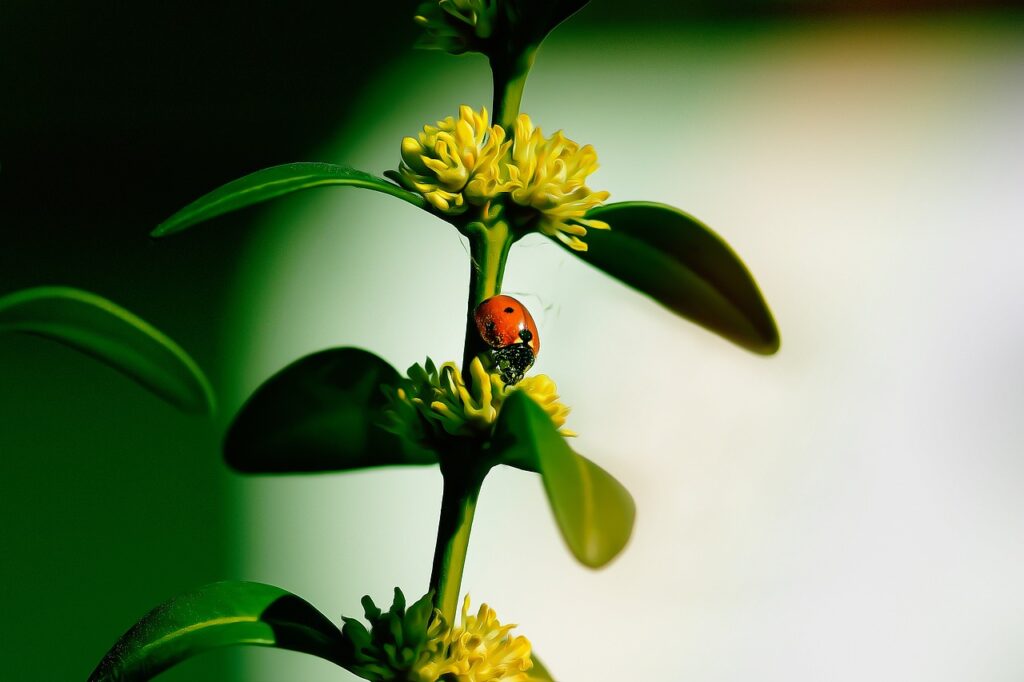
Creating Homemade Traps
Vinegar Trap
A vinegar trap can be easily made using common household items. Take a glass or jar and fill it with equal parts vinegar and water. Next, add a few drops of dish soap to the mixture and stir well. Cover the glass or jar with plastic wrap, securing it tightly with a rubber band. Finally, poke several small holes in the plastic wrap. Flies will be attracted to the scent of vinegar, enter through the holes, and become trapped in the mixture. Empty the trap regularly and replace the solution to maintain its efficacy.
Fruit Trap
Flies are naturally attracted to the scent of ripe fruits. To create a fruit trap, take a shallow bowl and fill it with ripe or overripe fruit pieces, such as bananas or apples. Next, cover the bowl tightly with plastic wrap, securing it with a rubber band. Finally, poke a few small holes in the plastic wrap. The smell of the fruits will lure flies to the trap, and once they enter through the holes, they will be unable to find their way out. Dispose of the trapped flies and replace the fruit bait as needed.
Milk and Pepper Trap
A milk and pepper trap is a simple yet effective homemade fly trap. Mix equal parts of milk and ground black pepper in a shallow bowl or plate. Place the mixture in areas where flies are common, such as near windows or doors. Flies will be attracted to the scent and the visual appeal of the mixture. However, upon landing on it, they will be deterred by the pepper’s irritant properties. This trap helps capture and eliminate flies without the need for harmful chemicals.
Jar Trap
A jar trap is a classic and straightforward method to catch flies. Take a small glass jar and add a sweet and sticky substance to the bottom, such as honey or syrup. Next, create a funnel using a piece of paper, with the wide end placed inside the jar, and the narrow end forming an entryway. Flies will be attracted to the sweet scent of the bait and will enter through the narrow end of the funnel. However, once inside, they will struggle to find their way out and become trapped in the jar.
Plastic Bag Trap
A plastic bag trap is an effective method to catch and eliminate flies. Fill a plastic bag halfway with water and add a few drops of dish soap. Hang the bag near windows or doors, ensuring that it catches the sunlight. Flies will be attracted to the reflective surface of the water and approach the bag. Upon landing on the water, the soap will reduce the surface tension, causing the flies to sink and drown. This simple yet ingenious trap helps control fly populations around your house.
Using Commercial Insecticides
Fly Spray
Fly sprays are readily available commercial insecticides that are specifically designed to eliminate flies. These sprays contain potent ingredients that effectively kill flies upon contact. When using a fly spray, make sure to follow the manufacturer’s instructions carefully. Spray the product in areas where flies are commonly found, such as near windows, doors, or trash bins. Ensure proper ventilation while using fly sprays and keep them away from children and pets.
Fly Baits
Fly baits are insecticide formulations designed to attract and kill flies. These baits come in various forms, such as granules or gels, and are formulated with fly attractants and toxic substances. Place the bait in fly-infested areas, following the product’s instructions. Flies will be lured by the smell of the bait and consume it, leading to their eventual demise. It is important to use fly baits responsibly, keeping them out of reach of children and pets.
Fly Strips
Fly strips, also known as fly ribbons, are sticky strips coated in a fly-attracting substance. These strips can be hung in areas where flies are prevalent, such as near windows, doors, or trash bins. Flies will be attracted to the sweet scent emitted by the strip and land on it, becoming stuck and unable to escape. Fly strips are an effective and affordable option for controlling fly populations, but they should be placed away from the reach of children and pets.
Insecticide Sprays
Insecticide sprays that are specifically labeled for use against flies can provide effective control when used correctly. Choose an insecticide spray that is safe for indoor use and follow the instructions provided by the manufacturer. It is important to use these sprays sparingly and only in areas where flies are a nuisance. Avoid spraying near food preparation areas or surfaces where children or pets may come into contact. Regular use of insecticide sprays can help eliminate flies and keep your house fly-free.
Bug Zappers
Bug zappers, also known as electric insect killers, are devices that attract and kill flies and other flying insects using a combination of light and electric grids. These devices emit ultraviolet light that attracts flies, and when the flies come into contact with the electric grid, they are electrocuted. Bug zappers can be hung in outdoor areas where flies are prevalent, such as patios or gardens. However, it’s important to note that bug zappers may also attract beneficial insects, so use them judiciously and consider placing them away from areas where people or pets frequent.
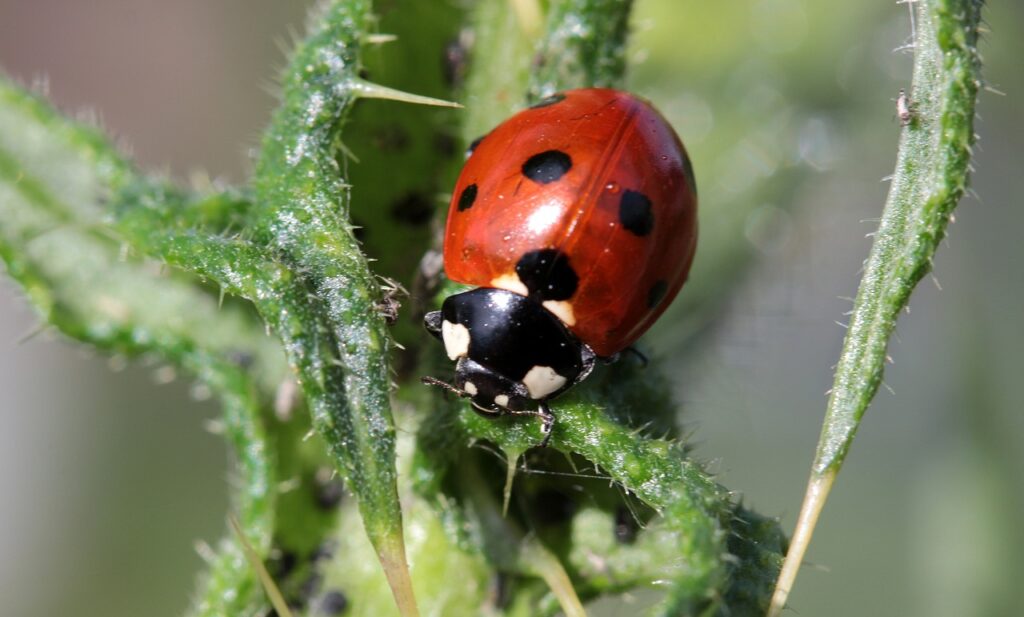
Proper Waste Management
Seal Trash Bins
Flies are highly attracted to the smell of decaying organic matter, making trash bins an ideal breeding ground for these pests. To prevent flies from infesting your trash, ensure that your trash bins are securely sealed with tight-fitting lids. This will help contain odors and discourage flies from accessing the trash.
Empty and Clean Bins Regularly
Regularly emptying and cleaning your trash bins is essential for preventing fly infestations. Dispose of garbage bags promptly, and wash your trash bins with a mixture of water and disinfectant regularly. This will help eliminate any lingering odors and residue that may attract flies.
Keep Trash Can Lids Closed
In addition to sealing your trash bins, it is important to keep their lids closed at all times. Make it a habit to close the lid immediately after disposing of garbage. This prevents flies from gaining access to the trash and reduces the likelihood of fly infestations in and around your house.
Dispose of Food Scraps Properly
Flies are particularly attracted to food scraps and leftovers. To prevent flies from being attracted to your kitchen and household waste, dispose of food scraps properly. Seal them in airtight containers or bags before placing them in the trash bin. This minimizes the odor and makes it less likely for flies to be enticed to the area.
Compost Bins
If you have a compost bin, it is important to manage it properly to prevent flies from infesting it. Make sure to follow composting guidelines and avoid putting meat, dairy products, or oily food in the compost. Cover your compost bin with a tight-fitting lid to contain odors and regularly turn the compost to discourage fly breeding. Properly managed compost bins can be a valuable tool for sustainable waste management without attracting flies.
Maintaining Cleanliness
Clean Daily
Daily cleaning is essential in preventing flies from infesting your house. Regularly sweep or vacuum floors to remove food crumbs and other debris. Wipe down countertops, tables, and other surfaces to eliminate any spills or food residues that may attract flies. By maintaining cleanliness, you remove potential food sources that would otherwise appeal to flies.
Remove Food Sources
Flies are primarily attracted to food, so it is important to remove any potential food sources that may attract them. Store fruits and vegetables in the refrigerator or in sealed containers. Keep bread, cereals, and other dry goods in airtight containers. Additionally, regularly clean pet food bowls and dispose of any uneaten food promptly. By eliminating accessible food sources, you reduce the likelihood of flies finding their way into your house.
Clean Pet Areas
If you have pets, it is important to keep their living areas clean to discourage flies from being attracted to them. Regularly clean litter boxes, cages, and bedding to prevent lingering odors that may attract flies. Wipe down food bowls and water dishes daily and promptly dispose of pet waste. By maintaining cleanliness in your pet areas, you minimize the chances of fly infestations.
Keep Surfaces Dry
Flies are drawn to damp environments, so it is important to keep surfaces in your house dry. Wipe down sinks and bathtubs after use to remove any standing water. Repair any leaks or plumbing issues that may create moist areas. By eliminating dampness, you make your house less attractive to flies and discourage their presence.
Clean Drains
Flies are known to breed in drains, particularly if there is residue and organic matter present. Regularly clean your drains using a drain cleaner or a mixture of vinegar and baking soda. Flush the drains with hot water to remove any buildup and prevent fly breeding. By keeping your drains clean, you reduce the chances of flies infesting your house.
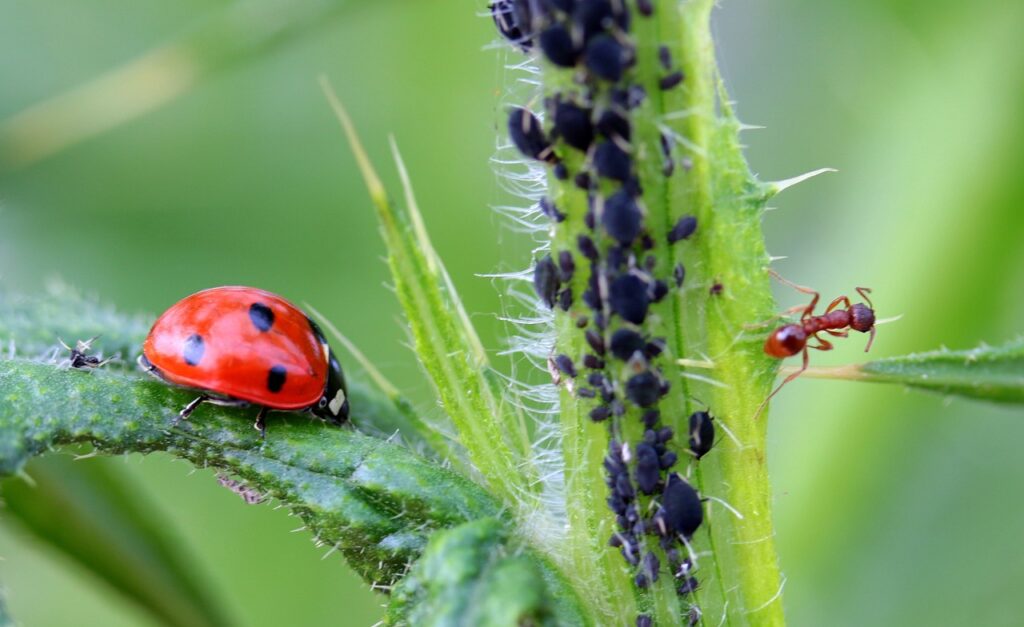
Effective Light Management
Use Yellow Bug Lights
Flies and other insects are less attracted to yellow bug lights compared to traditional white lights. Replace your outdoor lights with yellow bug lights to minimize the attraction of flies to your house. Yellow bug lights emit light in wavelengths that are less enticing to insects, providing you with illumination while reducing the presence of flies.
Keep Outdoor Lights Off
If flies are a persistent problem around your house, consider keeping your outdoor lights off as much as possible. Flies are more active during the evening and night when it is darker. By limiting outdoor lighting, you reduce the risk of attracting flies to your house.
Cover Windows at Night
Covering your windows at night can help prevent flies from seeing the light emitted from your house and being drawn to it. Close blinds or curtains to block the light from escaping and potentially attracting flies. This simple step can significantly reduce the chances of flies entering your living spaces.
Use UV Light Traps
UV light traps, also known as fly traps or fly lights, are devices that use ultraviolet light to attract flies and other flying insects. These traps emit UV light, which is highly attractive to flies. Once flies are drawn to the light, they are either trapped on sticky surfaces or electrocuted by an electric grid. UV light traps can be placed strategically near entrances or in areas where flies are a nuisance, providing an effective means of control.
Install Fly Curtains
Fly curtains, also known as insect curtains or fly screens, are a great way to prevent flies from entering your house while allowing fresh air to flow in. These curtains consist of thin strips of plastic or fabric that hang vertically from a doorway. They create a barrier that prevents flies from entering while allowing you to move freely in and out of the house. Installing fly curtains on frequently used doors can be an effective means of keeping flies at bay.
Eliminating Breeding Sites
Clean Gutters
Flies can lay their eggs in damp, organic matter such as decomposing leaves and twigs that accumulate in gutters. Regularly clean your gutters to remove any debris that may serve as a breeding site for flies. By maintaining clean gutters, you eliminate potential fly breeding grounds around your house.
Maintain Yard Hygiene
Flies can breed in yards that have tall grass, decaying vegetation, or standing water. Regularly mow your lawn to prevent it from becoming a suitable breeding site for flies. Dispose of fallen leaves and garden trimmings properly, and avoid leaving stagnant water in containers or other areas of your yard. By maintaining good yard hygiene, you reduce the chances of flies infesting your outdoor spaces and entering your house.
Remove Standing Water
Flies require standing water to breed, so it is crucial to eliminate any sources of stagnant water around your property. Regularly inspect your yard for areas where water accumulates, such as clogged gutters, potted plants with trays, or low-lying areas. Drain or remove any standing water to prevent flies from breeding.
Cover Rain Barrels
Rain barrels are a common source of standing water, making them potential breeding grounds for flies. To prevent flies from infesting your rain barrels, cover them with tightly fitting lids or mesh screens. This prevents flies from accessing the water and laying their eggs.
Treat Puddles
If you have puddles or small bodies of water in your yard that cannot be eliminated, consider using larvicides to treat them. Larvicides are products designed to kill fly larvae before they reach adulthood. Follow the instructions provided by the manufacturer to effectively treat the puddles and reduce the fly population in your surroundings.
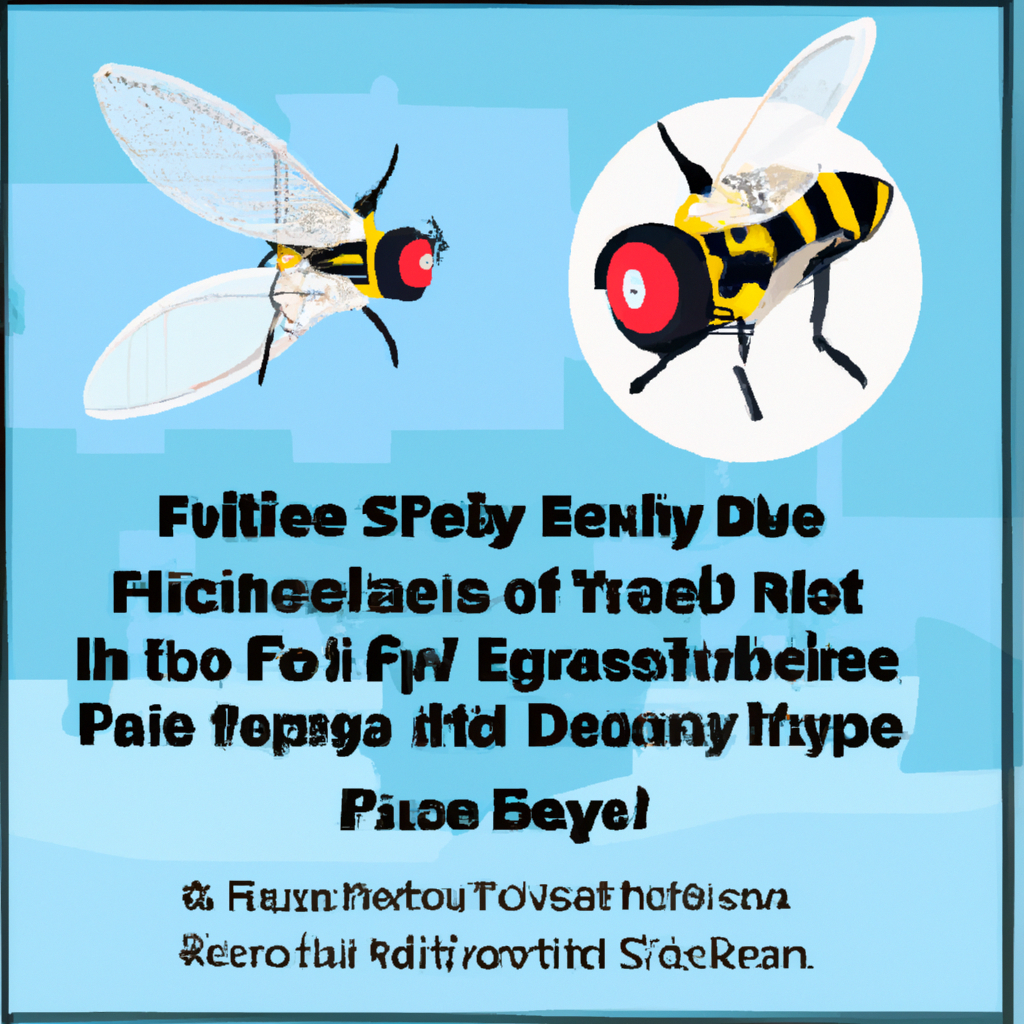
Employing Mechanical Control
Flyswatters
Flyswatters are a classic and effective method of physically eliminating flies. Keep a flyswatter handy in areas where flies are prevalent, such as kitchens or outdoor patios. When you spot a fly, simply swipe the flyswatter in its direction to squash it. Flyswatters provide immediate results and do not require the use of chemicals, making them a simple and eco-friendly option for fly control.
Fly Paper
Fly paper, or sticky fly traps, is a type of adhesive strip coated with a sticky substance. Hang fly paper in areas where flies are commonly found, such as near windows, doors, or trash bins. Flies will be attracted to the adhesive surface of the paper and become stuck upon contact. Fly paper is a passive yet effective method of trapping and eliminating flies.
Fly Vacuums
Fly vacuums, also known as bug vacs, are handheld devices specifically designed to capture and eliminate flies. These vacuums use suction power to trap flies without harming them. Simply aim the device at the fly and activate the vacuum function to draw it in. Fly vacuums are safe, hygienic, and provide a quick and hassle-free method of fly control.
Fly Traps
Fly traps are designed to attract flies and trap them without the need for pesticides or harmful chemicals. These traps use food baits or pheromones to lure flies into a container from which they cannot escape. Fly traps are available in various designs, such as bottle traps or bag traps. Place them in areas where flies are prevalent, following the instructions provided, to effectively capture and eliminate flies.
Sticky Fly Ribbons
Sticky fly ribbons, also known as fly catchers or fly ribbons, are strips of adhesive material that dangle from a hook or ceiling. Hang fly ribbons in areas where flies are common, ensuring they are within reach of the flying insects. Flies will be attracted to the ribbon’s adhesive surface and become stuck upon contact. Fly ribbons offer a simple yet effective means of capturing and controlling flies.
Seeking Professional Help
Hiring Pest Control Services
If you have a severe fly infestation that persists despite your best efforts, it may be necessary to seek professional help. Pest control services have the expertise and specialized equipment to effectively eliminate flies and implement preventive measures. Contact a reputable pest control company to assess your situation and provide tailored solutions to eradicate the fly problem in your house.
Ultrasonic Devices
Ultrasonic devices emit high-frequency sound waves that are designed to repel flies and other pests. These devices can be plugged into an electrical outlet and emit sounds that are not detectable to humans but are intolerable to flies. Ultrasonic devices offer a chemical-free and non-intrusive method of repelling flies from your house. It’s important to note that the effectiveness of ultrasonic devices may vary, and it is advisable to follow the manufacturer’s instructions and place them strategically for best results.
Fly Predatory Insects
Introducing fly predatory insects, such as parasitic wasps or fly-destroying beetles, can be an effective and natural method of fly control. These beneficial insects are natural predators of flies and can be purchased from specialized suppliers. By releasing these insects into your yard or indoor spaces, they will help reduce the fly population by hunting and feeding on the flies. Consult with experts or pest control professionals to determine the most suitable predatory insects for your specific situation.
Exterior Treatments
In some cases, treating the exterior of your house may be necessary to eliminate fly infestations. Pest control professionals can apply targeted insecticide treatments to the exterior walls, windows, and other areas where flies are likely to enter or reside. These treatments create a barrier against flies and help prevent their entry. Exterior treatments should be done by licensed professionals to ensure the correct application and minimize any potential risks.
Consulting Experts
If you are facing persistent fly problems and have exhausted all other methods, it may be helpful to consult experts in the field. Entomologists or pest control specialists can provide valuable insights and recommendations based on their knowledge and experience. They can assess your property, identify the root cause of the fly infestation, and offer effective solutions to eliminate flies from your house. Consulting experts can give you peace of mind and ensure a comprehensive and targeted approach to fly control.
By implementing these effective ways to eliminate flies in your house, you can create a clean and fly-free environment for yourself and your family. From preventive measures like sealing cracks and gaps to using natural repellents, creating homemade traps, and employing mechanical control, there are various strategies you can employ to keep flies at bay. Proper waste management, cleanliness, light management, and targeted elimination of breeding sites further enhance your ability to control fly populations. If needed, seeking professional help or consulting experts can provide additional guidance and resources. With persistence and a comprehensive approach, you can enjoy a fly-free living space and a more comfortable home.
